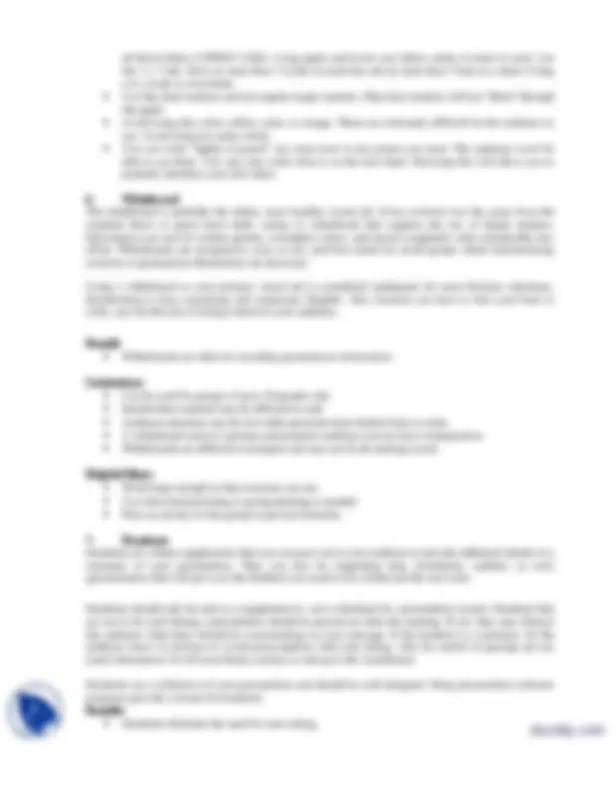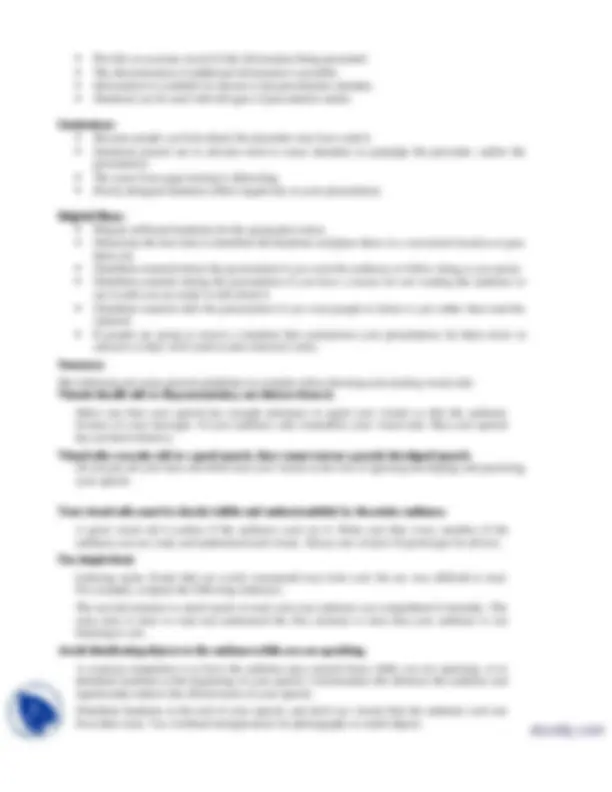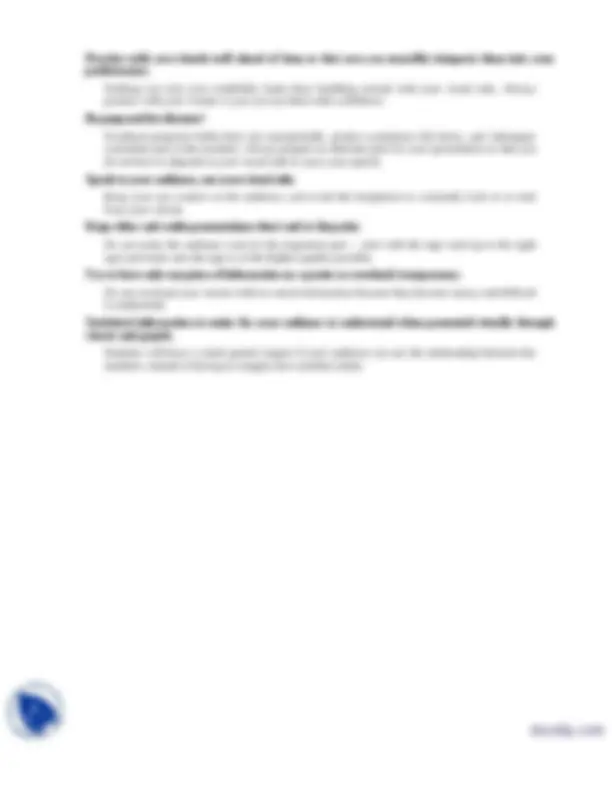





Study with the several resources on Docsity

Earn points by helping other students or get them with a premium plan


Prepare for your exams
Study with the several resources on Docsity

Earn points to download
Earn points by helping other students or get them with a premium plan
Community
Ask the community for help and clear up your study doubts
Discover the best universities in your country according to Docsity users
Free resources
Download our free guides on studying techniques, anxiety management strategies, and thesis advice from Docsity tutors
Communication is a process, which involves sharing of information between people through a continuous activity of speaking, listening, and understanding. Communication is important factor in business management. This lecture includes: Visual, Aid, Limitation, Benefit, Hint, Helpful, Overhead, Transparencies, Presentation, Point, Reveal, Projection
Typology: Exercises
1 / 5

This page cannot be seen from the preview
Don't miss anything!




4. Overhead Transparencies Overhead projection is the most versatile and popular presentation medium used by businesses today. Because of its effectiveness and wide acceptance, its popularity is continuing to grow. The projectors are brighter, quieter, and more portable, and high-quality transparencies can now be printed in full color directly from your computer. Overhead projection gives you control over every aspect of your presentation. By allowing you to face your audience in a fully lighted room, you are able to maintain the eye contact necessary for effective two-way communication. (Never face the “projected” image on the screen. Many presenters face the screen and end up talking to the screen). Facing the audience, you can detect audience confusion and easily clarify by highlighting, underlining, or circling important points with a project-able marker. If you need to explain further place a sheet of un-imaged film or write-on film on the stage of the overhead and use it as an "electric blackboard." By using a technique called revelation, information on your visual can be revealed point-by-point, preventing the audience from reading ahead or jumping to conclusions. If you want undivided attention, simply turn the projector off and all eyes are on you. Overhead projection provides an informal, but structured atmosphere where an audience expects to learn and is naturally invited to participate. It supports the presenter, enhances the communication process, and shortens meetings. Benefits Presenter has complete control over the presentation. Presenter faces the audience in a fully lit room. Visuals can easily be rearranged or omitted to fit the needs of the presenter or audience. Material can be highlighted or revealed point-by-point. Material can be created or added during a presentation using a projectable marker. Transparencies are easy and inexpensive to produce. An overhead projector is comfortable and simple to use. Limitations: Can be used for groups of up to 100 people. Presenter must rely on equipment. Older projectors tend to be dim and noisy. Presenter is forced to remain near the projector in order to change transparencies. Audiences that don't understand the benefits of overhead projection may perceive it as outdated. Helpful Hints: Test to see if the visual is in focus and if the projector is the right distance from the screen before you begin. Place the overhead to your RIGHT if you are right handed and to your LEFT of you are left handed-This will make it easier for you to face your audience and write if you need to. In either case, you want to stand in the center of the speaking area. Place your overhead projector on a table low enough so it does not block you or the screen. Have a small table next to the overhead so you can stack your overheads before and after you use them. To create a smooth transition and keep the audience from staring at a glaring white screen, turn the projector off before placing the next transparency. Be sure you have a spare lamp. Nothing is more unsettling than to have your overhead projector bulb goes out during your presentation. Bring spare bulbs and a glove to change the bulb. The old bulb will be HOT! Make sure you know how to change the bulb.
Don't look at or point to the screen, look at the transparency or maintain eye contact with your audience. Use a pencil, pointer, or color highlighting system when pointing to a transparency on the stage of the projector. To reveal one line at a time, put a sheet of paper under your transparency and slide it toward you as you discuss each item. If you want the attention focused on you and a point you're emphasizing, turn the overhead projector off and move inward the group. Make sure what's projected is short and simple. Tape the power chord to the floor-to protects you or someone else from tripping. Mount transparencies in a frame for easy handling. Write your name on mounting frames and number them.
5. Flipcharts While everyone seems to be interested in creating high-tech computer generated presentations, the flip chart still continues to be the most effective presentation media of all. One should not assume that investing a lot of money in high tech visual aids & equipment will "make" your presentation. The best visuals have been and still are the simplest. Whether hand-written or professionally imaged, the flip chart remains one of the most popular means of presenting meeting room information. An easel is comfortable, reliable, non-threatening (to you and your audience), and usually readily available. Flipcharts are ideal for recording audience input, reinforcing important points, or gathering information obtained during brainstorming sessions. It is an ideal presentation medium for executive offices, small conference rooms, onsite locations, and courtrooms--any location where projection equipment is unavailable or doesn't suit the environment. Benefits: Clip charts do not need electricity - You don't need to worry if the bulb will burn out or worry about additional presentation equipment. Flip charts are economical - They do not require you to use any special films or printers to produce them. Flipcharts can be used in fully-lit rooms, allowing the presenter to be the focus of the presentation Handwritten flipcharts are ideal for brainstorming sessions and encourage participation when used to record audience input The easel is reliable, predictable, comfortable and readily available Flipcharts can be used in a variety of environments that aren't suitable for projection equipment-- outdoors, small rooms and on-site locations Flip charts allow spontaneity - Any last minute changes can be easily made. Limitations: Can be used for group of up to 35 people only. Presenter must have high energy. Handwritten flipcharts require good penmanship and still may be difficult to read. Handwritten flipcharts lack professionalism and credibility. Preparation of handwritten flipcharts is labor intensive and therefore costly to produce. Helpful Hints: Make sure the flip charts you use will fit the flip chart stand you will be using. Some have different spaced holes at the top. When preparing your charts, it is best to first design your charts on paper first before drawing them on the actual flip chart pad. Lightly write your text in pencil first before using the actual flip chart markers. This will allow
Provide an accurate record of the information being presented. The dissemination of additional information is possible. Information is available for absent or late presentation attendee. Handouts can be used with all types of presentation media. Limitations: Because people can look ahead, the presenter may lose control. Handouts passed out in advance tend to cause attendees to prejudge the presenter. and/or the presentation. The noise from page turning is distracting. Poorly designed handouts reflect negatively on your presentation. Helpful Hints: Prepare sufficient handouts for the group plus extras. Determine the best time to distribute the handouts and place them in a convenient location or pass them out. Distribute material before the presentation if you want the audience to follow along as you speak. Distribute material during the presentation if you have a reason for not wanting the audience to see it until you are ready to talk about it. Distribute material after the presentation if you want people to listen to you rather than read the material. If people are going to receive a handout that summarizes your presentation, let them know in advance so they won't need to take extensive notes. Summary The following are some general guidelines to consider when choosing and creating visual aids: Visuals should add to the presentation, not distract from it. Make sure that your speech has enough substance to equal your visuals so that the audience focuses on your messages. If your audience only remembers your visual aids, then your speech has not been effective. Visual aids can only add to a good speech, they cannot rescue a poorly developed speech. Do not put all your time and effort into your visuals at the risk of ignoring developing and practicing your speech. Your visual aids must be clearly visible and understandable by the entire audience. A great visual aid is useless if the audience can't see it. Make sure that every member of the audience can see, read, and understand each visual. Always use at least 18 - point type for all text. Use simple fonts Lettering styles (fonts) that are overly ornamental may look cool, but are very difficult to read. For example, compare the following sentences: The second sentence is much easier to read, and your audience can comprehend it instantly. The extra time it takes to read and understand the first sentence is time that your audience is not listening to you. Avoid distributing objects to the audience while you are speaking. A common temptation is to have the audience pass around items while you are speaking, or to distribute handouts at the beginning of your speech. Unfortunately this distracts the audience and significantly reduces the effectiveness of your speech. Distribute handouts at the end of your speech, and don't use visuals that the audience can't see from their seats. Use overhead transparencies for photographs or small objects.
Practice with you visuals well ahead of time so that you can smoothly integrate them into your performance. Nothing can ruin your credibility faster than fumbling around with your visual aids. Always practice with your visuals so you can use them with confidence. Be prepared for disaster! Overhead projector bulbs burn out unexpectedly, posters sometimes fall down, and videotapes sometimes jam in the machine. Always prepare an alternate plan for your presentation so that you do not have to depend on your visual aids to carry your speech. Speak to your audience, not your visual aids. Keep your eye contact on the audience, and avoid the temptation to constantly look at or read from your visuals. Keep video and audio presentations short and to the point. Do not make the audience wait for the important part -- start with the tape cued up to the right spot and make sure the tape is of the highest quality possible. Try to have only one piece of information on a poster or overhead transparency. Do not overload your visuals with too much information because they become messy and difficult to understand. Statistical information is easier for your audience to understand when presented visually through charts and graphs. Statistics will have a much greater impact if your audience can see the relationship between the numbers, instead of having to imagine how numbers relate.